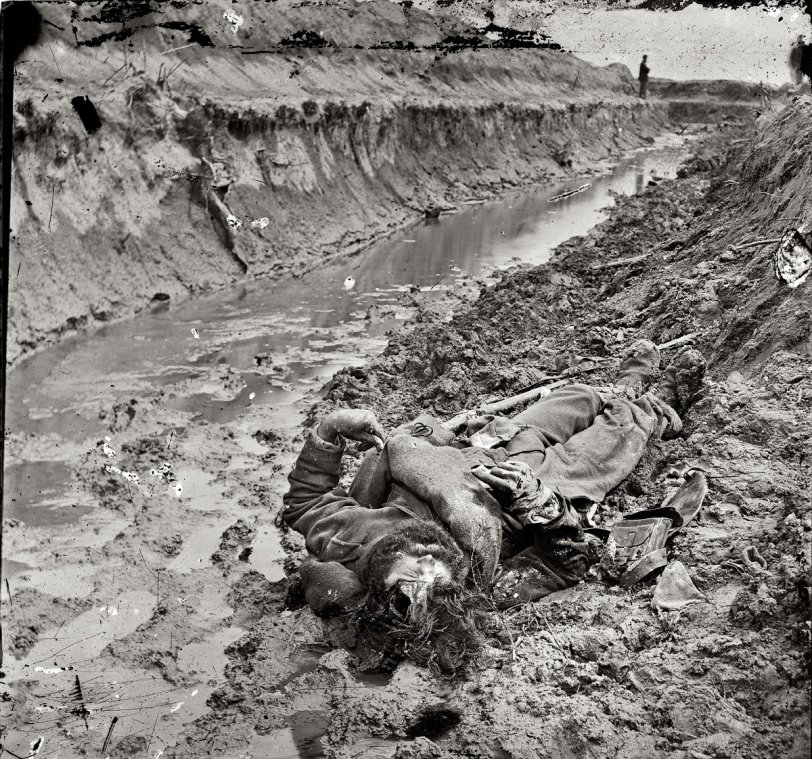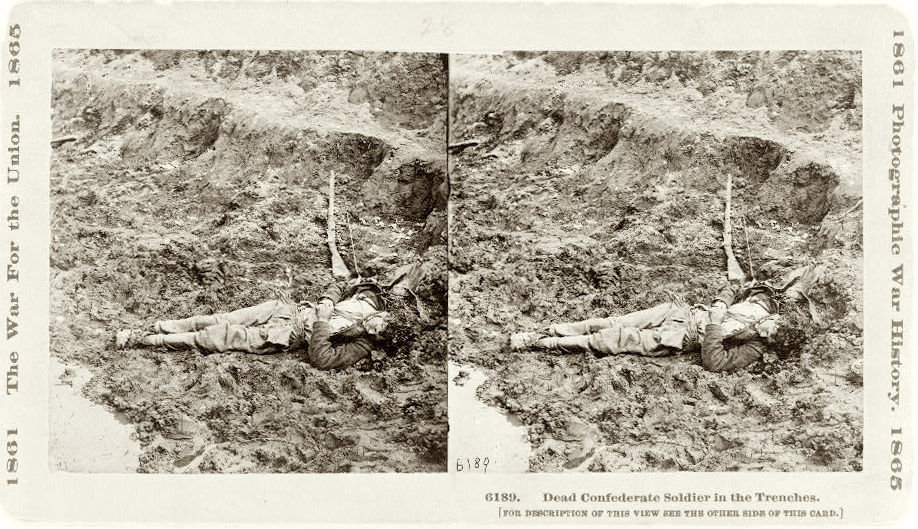


Framed or unframed, desk size to sofa size, printed by us in Arizona and Alabama since 2007. Explore now.
Shorpy is funded by you. Patreon contributors get an ad-free experience.
Learn more.

- Icing Platform?
- Indiana Harbor Belt abides
- Freezing haze
- Corrections (for those who care)
- C&NW at Nelson
- Fallen Flags
- A dangerous job made worse
- Water Stop
- Passenger trains have right of way over freights?
- Coal
- Never ceases to amaze me.
- Still chuggin' (in model form)
- Great shot
- Westerly Breeze
- For the men, a trapeze
- Tickled
- Sense of loneliness ...
- 2 cents
- Charm City
- What an Outrage
- Brighton Park
- Catenary Supports
- Just a Little Before I was Born
- Afternoon normal
- The Flat Iron Cafe survives
- Aging in Place
- Raise your hand
- Good and Bad
- Oh, the 70's
- Nooooooi
Print Emporium
Dies Irae: 1865

April 3, 1865. Petersburg, Virginia. "Dead Confederate soldier in trenches of Fort Mahone." Wet plate glass negative, left half of stereo pair, by Thomas C. Roche. Civil War glass negative collection, Library of Congress. View full size.
Muddy death
The original photo caption by photographer T.C. Roche states that the dead rebel soldier had been hit in the head by a solid shell and part of his head is missing. His rations are scattered around him and the trench has 2 feet of water in it. When viewed in the original stereo 3 dimensional form the photos must be quiet disturbing.
Cartridge box
The "sturdy looking satchel" is a cartridge box. It held 40 rounds in two tin inserts.
Looting
Whatever was in the rather sturdy looking satchel, (personal effects or ammunition?) appear to have been looted. It also looks like his belt has been partially removed and his pockets checked.
Looting corpses, even in 1865, was a violation of military law.
[From commenter Charlie in a different post: "There were no 'dog tags' then and so the soldier would write his name and hometown on a scrap of paper and carry it in his pocket so his body could be identified if needed. You will see the turned out pockets on almost all the dead." - Dave]
Up and Down
The contrast between the dead soldier and the live soldier (or soldiers? the one on the right is unclear) makes this image that more poignant.
The Dimensions of War
Granted, there was some real frippery associated with stereoscope cards -- "cute" pictures like the "Military Salute," -- but properly processed, the 3-dimensionality of these images can be pretty jaw-dropping, even with ordinary objects like the Moon. So long after the fact, we can only imagine the impact something like these war images might have had.
These cards may not have been immediate in the sense of time, but, until Vietnam, war coverage was always delayed. Profit motive aside, these photos were journalism and, as you've noted elsewhere, not subject to the sensibilities of the sketch artist. In that manner, these images were immediate. As the comments make clear, after 150 years they're "still" immediate.
Steve Miller
Someplace near the crossroads of America
Post Mortem
"Why were these pictures taken?" Lest we forget, lest we forget.
Pictures of dead soldiers
Except for the Crimean War, nobody had ever seen photographs of the real effects of war. People glorified the noble cause, one side or the other, but had no inkling of the true grisly horror of war. The photographers of the day felt it was their duty to bring this grim reality to the folks back home. Yes, it's shocking and horrifying, but every generation needs to be reminded of the true horror of war.
[These pictures were taken for profit; what you see here are the beginnings of the modern entertainment industry. Sold as stereoscope cards, they were a huge fad in the mid-19th century. Perhaps the first example of a mass-market home entertainment gadget before the phonograph and player piano came along. - Dave]
Re: Dies Irae
Dies Irae means Day of Wrath. I believe there is a latin hymn with this name that reaches back 500 years or so. It's appropriate here and in Kubrik's film.
[As noted below, it denotes one of the nine parts of the Requiem Mass. - Dave]
Dies Irae
Is an ancient Latin Chant used before Vatican II in Requiem Masses (for the dead). It translates into "Day of Wrath" and describes what awaits in the Last Judgment. After Vatican II the emphasis became God's love and forgiveness and the old reminders like this one have fallen into disuse, except for pop culture whose proponents have little idea of what it once stood for.
Re: OMG
In an era without TV or radio, this was the only way that the homefront could connect with what was going on in the War. Victorian customs were different than ours are today. Many people took pictures of their dead loved ones (especially children) before they were buried.
Dies Irae and Thomas Roche
"Dies irae" is Latin for "the days of wrath." It is an important hymn in the Requiem Mass, which is usually said in order to pray for departed souls.
Roche was an employee of Mathew Brady, who was a Northern photographer who extensively documented the Civil War and acted as a kind of press agency, buying other photographers' works and selling them to newspapers and other publications. He was the first to document war as it really was - he was unable to deploy the romanticism of the war artists that had illustrated war despatches before, because the camera doesn't lie.
Sensibilities of the time were deeply shocked, much as your were. 150 years of remove from this man's brutal death, the reality of war has not lost its power to shock. I think Brady would be proud.
Casualties of War
Why take these pictures? Maybe it was hoped that the new technology of photography would show the stark tragedies of conflict and make men less likely to clamor for the fight.
"It is well that war is so terrible, or we should grow too fond of it." - Robert E. Lee
OMG
Is that a hole in his skull? Does anyone know why they took pictures of these dead soldiers?

























On Shorpy:
Today’s Top 5